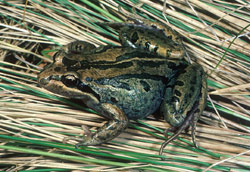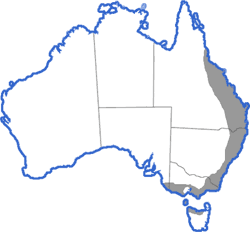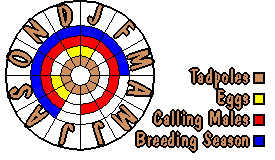Limnodynastes peroni
Striped Marsh Frog
Also: Brown Frog, Brown-striped Frog, Night Frog, Peron's Marsh Frog, Swamp Frog

+ 72 kb Striped Marsh Frog (Limnodynastes peroni)
A large wetland-dwelling frog and voracious hunter, this frog eats almost any animal smaller than itself, including small frogs. Its distribution extends along the east coast from Queensland to South Australia. It is most commonly associated with wetlands and permanent water and shelters among reeds and other debris.
Distribution and habitat

Adults can be found in rainforests, wet and dry forests, woodlands, shrublands, open and disturbed areas where they frequent swamps, flooded grasslands, pools and ponds. Eggs and tadpoles are found in still or very slow moving water in swamps, lakes, dams, and isolated ponds.
There is a detailed distribution map available for: Victoria.
Calling
Males call from the water concealed in vegetation or sometimes concealed under the egg masses. The call is a single short soft explosive note very similar to that of the southern call race of Limnodynastes tasmaniensis. A "tock" or "poc" with similar inflections to a hen's "cluck".
Copyright Murray Littlejohn. Recorded by Murray Littlejohn. Must not be reproduced without permission.
Life cycle

Distinguishing characteristics

+ 55 kb Striped Marsh Frog (Limnodynastes peroni)
Adult
length: 45-75mm.
Eggs may be pigmented (east of Melbourne) or unpigmented (west of Melbourne) and are contained within a foam raft concealed in reeds, rushes, and other aquatic vegetation. Tadpoles are usually light brown or silvery grey on both body and fins. Adults range from pale fawn to golden-brown with dark brown or black longitudinal stripes along the back. Juveniles may have only a series of longitudinally aligned spots or streaks.
Visible features
Presented here is the information stored in the frogs.org.au database which is used to identify frogs based on their appearance. It is intended to be used in a key guide for separating species so some of the information (for example, back colours) may be rather non-specific. The system is currently being developed - if you notice errors in the data, please write to Dave Black at the address at the bottom of the page.
Important note: This information details only the appearance of the frog. If an "or" appears in the description, this may mean either that there is some variation within the species or that the feature might be observed differently by different people. For example, if a frog has very small toe pads, it may be listed as having "Toe pads: present or absent".
Size
Up to between 60mm and 90mm
Eyes, hands, and feet
Pupils: horizontal
Toe pads: absent
Webbing on feet: no webbing
Belly
Texture: smooth
Pattern: plain
Colour: single colour
Back
Texture: smooth
Pattern: striped
Colour: multi-coloured
Glands and tubercles
Parotoid gland: absent
Tibial gland: absent
Metatarsal tubercles: Non-keratinised glands present (fleshy or uncoloured)
Similar species (note: this version was written for Victorian species).
The distinct markings of this frog make it easy to distinguish from all other species of its size. Its conspicuous golden or light brown back with dark brown or black stripes is unique.
Limnodynastes peroni image gallery
Metamorphlings
The scientific names of Limnodynastes peroni
Alternate spelling: Limnodynastes peronii
- Cystignathus peronii (Dumeril & Bibron 1841)
- Limnodynastes krefftii (Gunther 1863)
- Limnodynastes kreftii (Steindachner 1867)
- Limnodynastes lineatus (De Vis 1884)
- Limnodynastes peroni (Dumeril & Bibron 1841)








